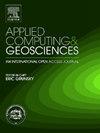A machine learning approach for mapping susceptibility to land subsidence caused by ground water extraction
IF 3.2
Q2 COMPUTER SCIENCE, INTERDISCIPLINARY APPLICATIONS
引用次数: 0
Abstract
Land subsidence is a worldwide threat that may cause irreversible damage to the environment and the infrastructures. Thus, identifying and mapping areas prone to land subsidence with accurate methods such as Land Subsidence Susceptibility Index (LSSI) mapping is crucial for mitigating the adverse impacts of this geohazard. Also, Machine Learning (ML) is now becoming a powerful tool to analyze vast and different datasets such as those necessary for LSSI mapping. In this study, we use the conventional Frequency Ratio (FR) method and ML models to generate LSSI maps of the region of Murcia (Spain) where land subsidence occurred in the past due to groundwater overdraft. A LSSI map was initially generated with known FR. Then, additional Conditioning Factors (CFs) with increased spatial resolution were used to train several ML models and generate a new LSSI map. The Extra-Trees Classifier (ETC) outperformed the other approaches, achieving the best performance with a weighted average precision and F1-Score of 0.96, after optimizing its hyperparameters. Then, a third LSSI map was calculated using the FR method and observations of land subsidence from InSAR (Interferometric Synthetic Aperture Radar). This study shows that the effectiveness of using several CFs depends on the added information of each layer. Moreover, the comparison between the different LSSI maps and InSAR data highlights the crucial role of the spatial resolution for accurate mapping, thus enhancing land subsidence risk assessment.
绘制地下水开采导致土地沉降易感性地图的机器学习方法
土地沉降是一种全球性威胁,可能对环境和基础设施造成不可逆转的破坏。因此,采用土地沉降易感指数(LSSI)绘图等精确方法识别和绘制易发生土地沉降的地区,对于减轻这种地质灾害的不利影响至关重要。此外,机器学习(ML)目前已成为分析大量不同数据集(如 LSSI 测绘所需的数据集)的有力工具。在本研究中,我们使用传统的频率比(FR)方法和 ML 模型来生成穆尔西亚地区(西班牙)的 LSSI 地图,该地区过去曾因地下水超采而发生过地面沉降。LSSI 地图最初是根据已知 FR 生成的。然后,使用空间分辨率更高的附加条件因子(CF)来训练多个 ML 模型,生成新的 LSSI 地图。优化超参数后,树外分类器(ETC)的表现优于其他方法,加权平均精度和 F1 分数均达到 0.96。然后,利用 FR 方法和 InSAR(干涉合成孔径雷达)的地面沉降观测数据计算了第三幅 LSSI 地图。这项研究表明,使用多个 CF 的有效性取决于每个层的附加信息。此外,不同的 LSSI 地图和 InSAR 数据之间的比较凸显了空间分辨率对精确制图的关键作用,从而加强了土地沉降风险评估。
本文章由计算机程序翻译,如有差异,请以英文原文为准。
求助全文
约1分钟内获得全文
求助全文
来源期刊

Applied Computing and Geosciences
Computer Science-General Computer Science
CiteScore
5.50
自引率
0.00%
发文量
23
审稿时长
5 weeks
 求助内容:
求助内容: 应助结果提醒方式:
应助结果提醒方式:


